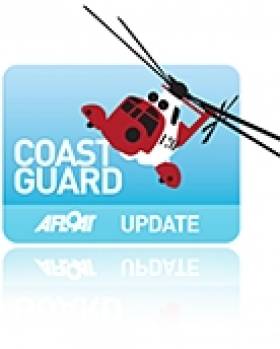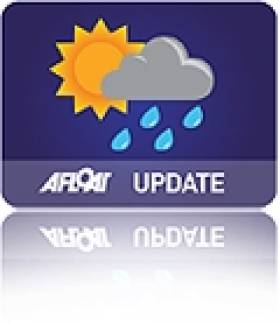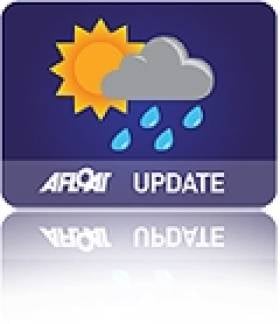Displaying items by tag: Weather Warning
Coast Guard Warning as Met Éireann Issues Orange Weather Alert
#weatherwarning – Southerly gales will develop overnight on all Irish coastal waters and on the Irish sea, gradually veering southwest to west later tonight and tomorrow and increasing gale to storm force. Frequent heavy showers, some thundery with sleet and snow for a time mainly on higher ground.
High coastal flood risk, due to the combination of very high spring tides, extremely high waves (greater than 10 m).
The Coast Guard strongly advises the public not to go out on exposed coasts, cliffs, piers, harbour walls, beaches, promenades or any other coastal areas during the inclement weather. Huge waves can be whipped up by high seas. These waves can pose hazards to anyone close to the shoreline.
Manager of the Irish Coast Guard, Declan Geoghegan said: " Extreme care should be taken in exposed areas especially cliffs, promenades, slipways and all beach areas also photography in these weather conditions has become popular and people should not put themselves at risk for such activities or indeed any water related leisure activities"
Remember to monitor weather broadcasts when travelling and heed the advice of the RSA on road use during severe weather and high winds.
Specific advice from the Coast Guard is:
• The public is advised to stay away from the shoreline and to avoid engaging in water sports
• Do not venture out unnecessarily when gale force conditions are forecast
• Avoid exposed coasts, cliff paths and coastal areas during inclement weather this week
• Owners of small vessels and fishing vessels in coastal waters should seek shelter and secure them properly with moorings.
If you do see someone in difficulty in the sea, on the shore, cliffs, lakes or rivers dial 999 or 112 and ask for the Coast Guard.
Severe Weather Alert Issued By Clare County Council
#weatherwarning – Clare County Council has issued a flood and storm warning for the entire county in advance of severe weather conditions that are expected during the next few days.
The local authority is urging land, home and business owners, particularly those in low lying coastal areas, to take precautionary steps in light of the flood risk posed by a combination of heavy rainfall, strong gale to storm force winds, a large sea swell and a Spring Tide.
"There is a serious risk countywide of both coastal and inland flooding and all areas which have flooded in the past could be seriously impacted. Conditions could be similar in nature and extent to the storm events of early January with the potential for structural damage," explained Tom Tiernan, Senior Engineer, Clare County Council.
He added: "Current firm indications are that severe weather conditions will pertain throughout the coming weekend commencing with a substantial rainfall event tomorrow (Friday). In addition, tide levels will be rising to a Spring Tide peak overnight on Friday/Saturday morning. This will be exacerbated by significant swell conditions and high Westerly and South Westerly winds which will continue through Saturday."
Mr. Tiernan confirmed that river levels remain "very high", and arrangements have been put in place to continuously monitor the situation.
He continued: "Clare County Council, in conjunction with the Emergency Services, is progressing contingency arrangements in terms of additional pumping capacity and other flood alleviation measures at flood prone locations. In the meantime, the advice is to take appropriate precautions and not to venture out unless necessary, particularly in coastal areas."
Flooding advice is available on www.flooding.ie . Information included on the website includes advice on identifying flooding risks, protecting property against flooding, necessary steps to be taken if a property is flooded, and assessing and repairing property damaged by flooding.
Weather Warning for Irish Sea as Winter Winds Sweep In
#WEATHER - Met Éireann has issued a weather warning for the Irish Sea for the next 24 hours due to expected gale force westery winds.
A small craft warning has also been issued, with west to southwest winds continuing to reach force 6 tonight on the Irish coast from Carlingford Lough to Roches Point to Slyne Head.
The high winds marks the first wave of real winter weather after a milder-than-average November, the Evening Herald reports.
A forecaster told the paper that strong winds have "reached storm force on the Irish coasts from Belfast Lough to Wicklow Head to Mizen Head and on the Irish Sea.
"We expect that by tonight they will slightly drop but may still reach a strong gale force."































































